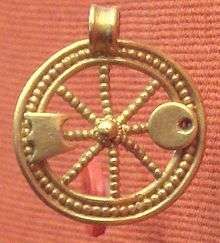Loucetios
In Gallo-Roman religion, Loucetios (Latinized as Leucetius) was a Gallic god known from the Rhine-Moselle region, where he was invariably identified with the Roman Mars.[1] Scholars have interpreted his name to mean ‘lightning’.[2] Mars Loucetius was worshipped alongside the goddess Nemetona.[3]
Inscriptions and shrines
About a dozen inscriptions in honour of Mars Loucetius have been recovered, mainly from eastern Gaul, with a particular concentration among the Vangiones and Aresaces (two Rhenish tribes). Inscriptions to him have also been found at Bath and Angers;[1] the altar at Bath specifies that it was dedicated by a citizen of the Treveri.[4]
Inscriptions often invoke Mars Loucetius together with Victoria or Nemetona[3] (or both, in the case of the Eisenberg inscription[5]). Edith Mary Wightman considers this pair “closely similar to if not identical with, Lenus and Ancamna”,[3] who are known chiefly from the territory of the Treveri adjacent to those of the Aresaces and Vangiones.
Four of the inscriptions to Mars Loucetius are also dedicated IN H(onorem) D(omūs) D(ivinae),[6] ‘in honour of the divine house’ (i.e. the imperial family).
Wightman further suggests that the shrine of Mars Loucetius at Klein-Winternheim, south of Mainz, was “a central one for the Aresaces”,[3] the ancient inhabitants of the Mainz-Bingen area.
Name and etymology
The name Loucetios may be derived from the Proto-Indo-European root *leuk- ‘shine’; Xavier Delamarre glosses the theonym as “Eclair” (‘lightning-flash’).[2] It is presumably analogous to Oscan Loucetius ‘light-bringer’, an epithet of Jupiter.[7] The Gaulish and Brythonic forms likely derive from Proto-Celtic *louk(k)et-, ‘bright, shining, flashing’, hence also ‘lightning’,[2] in reference to either a Celtic common metaphor for battles as thunderstorms (Old Irish torannchless, the "thunder feat"), or else the divine aura of the hero (the lúan of Cú Chulainn).[8] Loucetios was also considered as Sulis Minerva's consort.[9]
Modern literature
In Neil Gaiman's American Gods, Leucotios [sic] appears in chapter three, during Shadow's (the main character) dream of forgotten gods. Gaiman's Leucotios is described as a “man with ... white hair, with a necklace of teeth about his neck, holding a drum”.[10]
References
- Nicole Jufer & Thierry Luginbühl (2001). Les dieux gaulois : répertoire des noms de divinités celtiques connus par l'épigraphie, les textes antiques et la toponymie. Paris: Editions Errance. pp. 48–49. The sites listed for Loucetius/Leucetius are Strasbourg, Worms, Eisenberg, Groß-Gerau, Klein-Winternheim, Frauenstein, Großkrotzenburg, Marienborn, Angers, and Bath.
- Xavier Delamarre (2003). Dictionnaire de la langue gauloise (2nd ed.). Paris: Editions Errance. p. 199.
- Edith Mary Wightman (1970). Roman Trier and the Treveri. London, England: Rupert Hart Davis. p. 219.
- RIB 1, 140.
- AE 2007, 1044.
- These are the inscriptions at Groß-Gerau (AE 1991, 1272), Großkrotzenburg (CIL XIII: 7412), Worms (CIL XIII: 6221), and Eisenberg (AE 2007, 1044).
- J.P. Mallory and D.Q. Adams (1997). Encyclopedia of Indo-European Culture. Taylor & Francis. p. 513. Missing or empty
|title=(help) - Helmut Birkhan (2006). "Loucetius". In John Koch (ed.). Celtic Culture: A Historical Encyclopedia. ABC-Clio. p. 1192.
- J. Koch, Celtic culture: a historical encyclopedia.
- Neil Gaiman (2001). American Gods. New York, NY: HarperTorch. p. 58.

